History
- Introduction
- The beginnings - Art Nouveau & Red Propaganda (1895 - 1919)
- Art Deco & Modernism (1920 - 1944)
- The distinctive poster art of a short-lived democracy (1945 - 1949)
- Socialist Realism and the continuity of the modern poster (1950 - 1955)
- A cavalcade of styles & techniques (1956 - 1970)
- The low-culture and the neo avantgarde (1971 - 1990)
Socialist Realism and the continuity of the modern poster (1950 - 1955)
Take a look at our inventory from this period by: clicking here.
The election in 1949 was the starting point of a new, dictatorial era. In the same year, a new constitution was written, which provided a strong basis for the communist regime. The power of the working class was supposed to be represented by the strong dictatorship of the Hungarian Workers’ Party, and its leader, Mátyás Rákosi. Meanwhile, the country was under the occupation of the Russian red army which took every aspect of the life of Hungarians under its control.
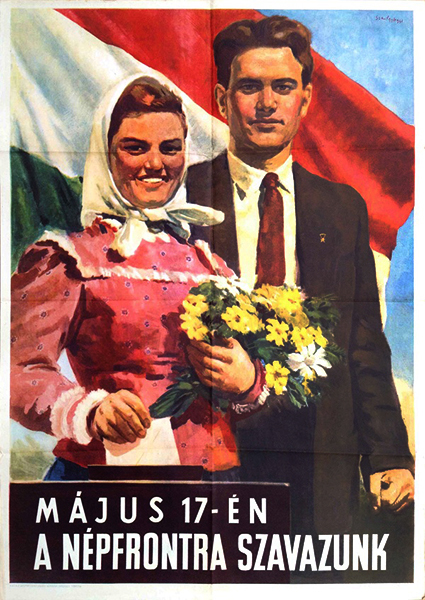
Kornel Szentgyorgyi - People's Front communist election poster propaganda Hungarian 1950s
These were the darkest years of communism, when the economy went thorugh a disastrous downfall and human rights were trampled. The period of this forceful dictatorship was ended by the revolution of 1956. Although the uprising did not manage to totally strike down the communist leadership, as a result of the extensive international awareness it had raised, the system slowly started to get softer, but only after the terrible initial retaliations following the revolt.

auckioMarine exhibition in Budapest 1918
After World War II the country was in ruins, and, despite the terrible financial conditions, the reconstructions had to start immediately. There were serious shortages of basic goods. After 1949, the nationalization of private property quickly began. The state controlled people's work and free time. In the totalitarian state, the denounced individuals were imprisoned or deported to labour camps. A network of informants was established so shortly the general atmosphere was soaked with fear and distrust. The brainwashing of society was of key importance; only the Marxist-Leninist ideology was approved. This strong control defined the poster design and the world of art as well. Socialist realism, developed in the USSR, became the obligatory style. According to the official ideology, realism serves the understanding of art; therefore avant-garde art is simply a decadent formalism what is impossible to interpret for the members of the working class.
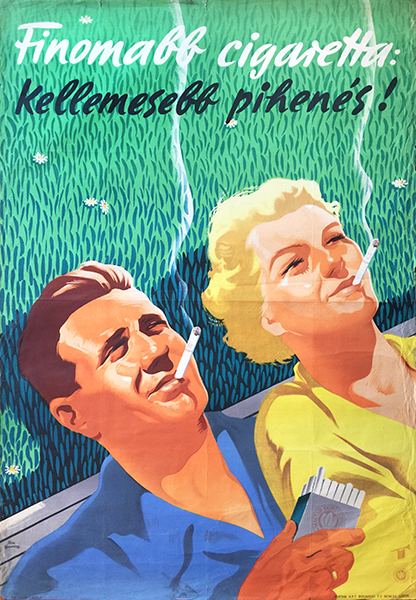
Fejes Macskassy Tastier Cigarettes Hungarian poster 1950
The themes of painting were also restricted; they were mostly scenes from the workers’ idealized lives. In the 1930s and 1940s, there was a realist tendency present in Hungarian poster art. For example, Tibor Gönczi-Gebhardt designed posters with plastic and monumental forms, and simple political symbols. This tradition gained ground in the 1950s, because it matched the expectations of the new regime. The revolutionary modern poster design of the short democratic period between 1945 and 1949 rapidly vanished. The principles of the rigid and ceremonial soviet poster design became the guidelines for Hungarian artists. This change meant the near exclusivity of socialist realism. Photo-like realistic human figures appeared on the posters, who were mainly idealized typical characters: smiling workers, proud peasants, housewives and children with theatrical gestures, standing straight with their heads up, staring into the distance. They are often marching or working at factories, mines, or wheat fields, laying the foundation of the bright future.
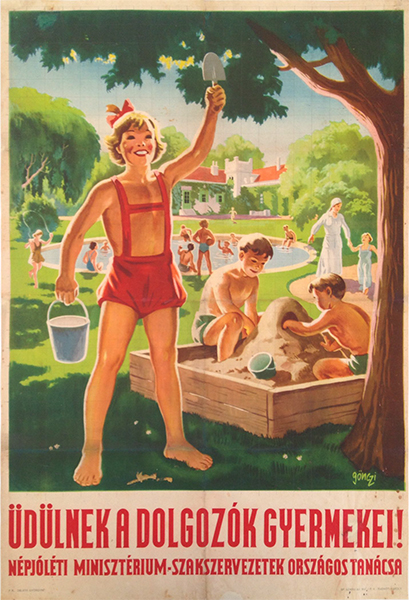
Tibor Gonczi Gebhardt - The Children of the Workers are on Vacation! 1950 Hungarian Communist propaganda poster
The posters were always painted, and all the paintings were made in exactly the same heroic manner, thus the paintings and posters looked alike. This transformation was easier for the conservative artists of the Horthy-era than it was for the modern, usually idealistic leftist artists, such as György Konecsni or Pál Gábor. Unlike them, Tibor Gönczi-Gebhardt, György Pál and Andor Bánhidi were able to adapt to the situation faster. Those who couldn’t identify with socialist realism rather specialized in designing posters for national exporting companies, or in designing typographical compositions, like Pál Gábor. With the centralization of advertising, the official standards of poster art were present everywhere. Every advertising activity had to be reported to the official bureau. The private companies were shut down, and the Hungarian Advertising Agency (Magyar Hirdető, or MAHIR, which was a nationalized company) supervised the publication of posters. Due to the aforementioned circumstances, commissions only came from state-owned companies and institutions.
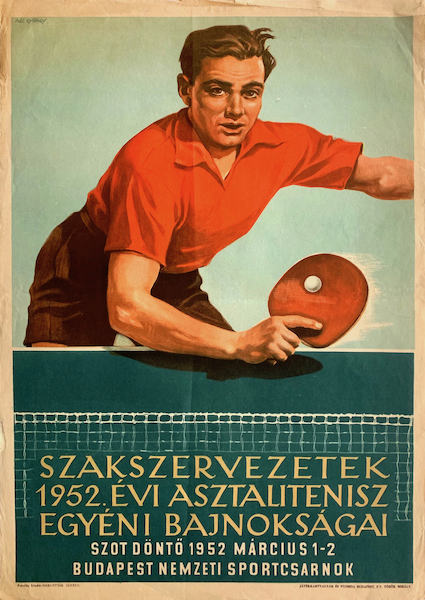
Pal Gyorgy - Table Tennis Championships 1952 Hungarian sport poster
The ideology and provisions of the new regime had to be promoted, and even negative events were always advertised with optimistic, smiling characters. As a means of convincing the masses that the situation of the economy was not as catastrophic as it was in reality a permanent enthusiasm on posters was required. New traditions had to be established, such as new public holidays, which were always supported with intensive poster campaigns. The most important ones were the anniversary of the socialist revolution (November 7), the Liberation (April 4), and the constitution (August 20), and the International Worker's Day (1st of May). Posters were made for the working competitions, the best, stakhanovist workers of the factories, the 3 and 5 years production plans, peace bonds, the so-called “fight for peace” campaigns, and for the Cold War propaganda: the preparedness for the next world war. Each aspect of everyday life was represented, since all activities became part of the new socialist lifestyle: sport, entertainment, culture, education and vacation.
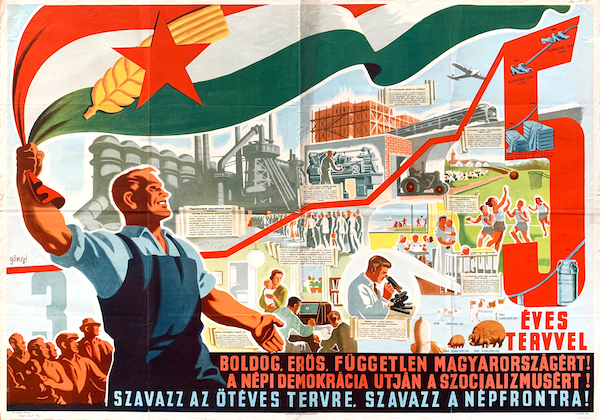
Tibor Gonczi Gebhardt - For a joyous, strong, independent Hungary! On the path of folk democracy for socialism! Vote for the Five Year Plan, vote for the People's Front! 1949 vintage Hungarian communist socialist realist propaganda poster
Gönczi-Gebhardt’s poster for the unification congress of the Social Democratic Party and the Hungarian Communist Party partly preserved the spirit of poster art in between 1945 and 1947, but it still shows the rigid, solemn nature of socialist realism, meanwhile it is a paraphrase of Vera Muhina’s famous sculpture. On Gönczi’s poster for the celebration of April 4 socialist realism culminates; it is a photo-like, painted composition, with smiling figures in front of a forest of flags, and the new symbol: the statue of liberty on Gellért Hill in Budapest. György Pál chose the motive of the Parliament for his poster for August 20 in 1950; a group of enthusiastic people are marching in front of it, bringing the new state coat of arms. Tibor Bánhegyi and István Czeglédi designed a poster for DISZ (Young Workers Association), which had a monumental effect; it depicts Rákosi standing above a group of smiling young people, in front of flags. Sándor Ék, the official artist who was an important graphic designer in the previous era, was still designing his drawn realist compositions, representing muscular workers and productive factories.
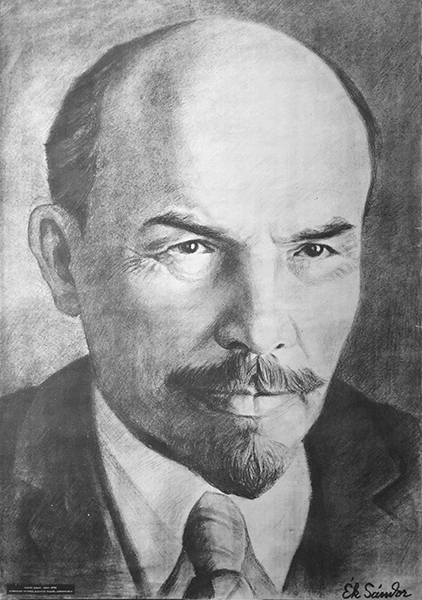
Sandor Ek - Lenin 1950 Hungarian Communist Socialist Realist propaganda poster
In 1949 Ernő Mihályfi (politician and the husband of poster designer Ilona Fischer FILO) declared that the posters can’t fulfill their great purpose of agitation. Furthermore, he didn’t dare to criticize the meaningless obligatory themes, the artificial style, and the guiding principle that the artists must represent the life of the working class in a specific manner. The Hungarian poster exhibition in Budapest in 1953 showed the dominance of socialist realism, and it was criticized (by some artists) for the low artistic value of the works. The decline of socialist realism started after 1956, after a poster exhibition in spring. The graphic artists rebelled against the compulsory poster style by their new designs. They decided to ignore the socialist realist tendencies, and declared that they would only create designs of high artistic value and poster-like posters.
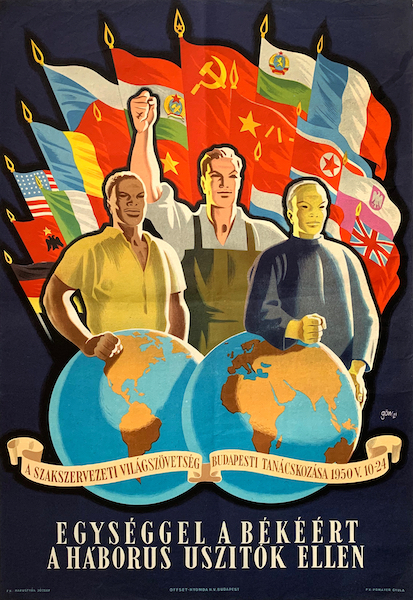
Tibor Gonczi Gebhardt - With unity against the war inciters - The meeting of the Trade Union World Federation in Budapest 1950 vintage Hungarian socialist realist communist propaganda event advertising poster
The posters promoting the exhibition are the representatives of a new poster style; they were designed by Pál Gábor, András Máté and Zoltán Tamássi, and all of them utilized compact composition, expressive brushwork and inspiring images. A new generation of graphic artists started to work on the field of poster design, who didn’t accept the socialist realist manner (Árpád Darvas, András Máté, Lajos Görög, István Balogh, Nándor Szilvássy, Gábor Papp, etc.). This new direction represented at the 1956 poster exhibition became successful despite the aversion of some art theorists (like Nóra Aradi). The exhibition was a new start; it ended the socialist realist era.
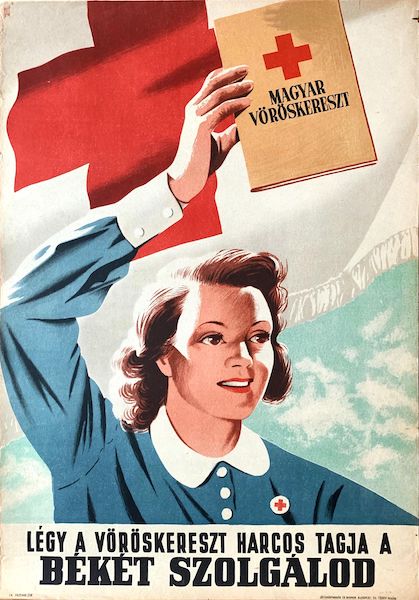
Matyas Gaal - Join the Red Cross (1952)
In 1953, Stalin’s death caused a minor change in the soviet system, de-Stalinization meant the process of eliminating the cult of personality, which was also present in Hungary at the time. In poster design it meant that Soviet and Hungarian communist leaders slowly disappeared from posters. In October,1956, a revolution broke out against the soviet regime. As mentioned above, after the bloody retaliations, the system started to get softer. The end of socialist realism brought a new golden age of poster art.
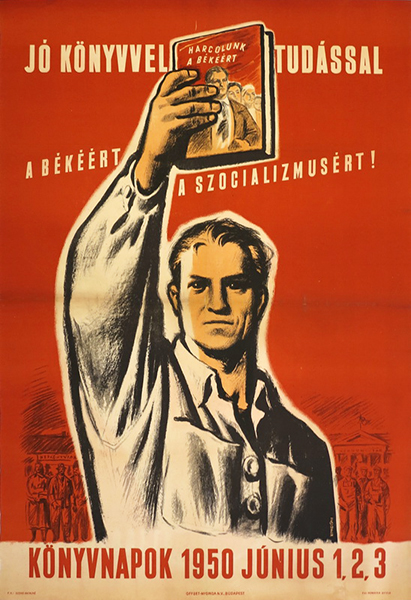
Book days for Socialism 1950 Hungarian communist propaganda poster
Today, most socialist realist posters look artificial and blatant, but they possess an obvious historical value. The best among them still eradiate an immensely powerful propagandistic effect, proving that the artist overcame the mandatory rules, and was able to create a masterpiece; these are rare and important artifacts.
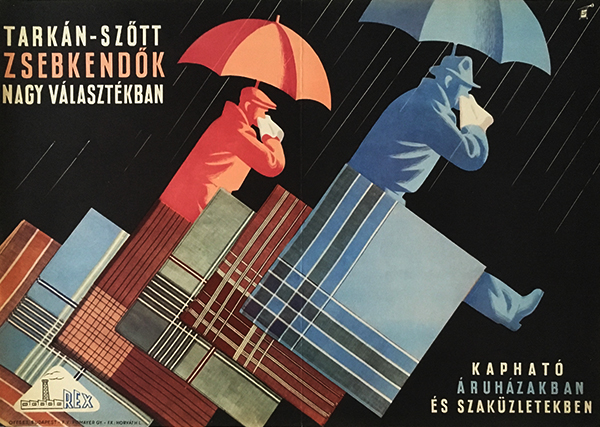
Tibor Gonczi Gebhardt - Colorful woven handkerchiefs 1955 Hungarian advertising poster
The approach used for the posters for exporting companies, which were meant to be sent abroad, was completely different from that of the local propaganda. The strong control of MAHIR wasn’t there, since the export companies (such as Chemolimpex, Nikex, Ferunion, Hungarotex, Agrimpex and Artex) still had independent advertising rights. Some former successful private companies, which were nationalized, could also execute export campaigns (like Orion and Tungsram). The export posters followed the international trends of poster design: they were clear, understandable, effective and decorative. They were free of the solemn festivity of socialist realism, and were more poster-like. Their style derived from the period between 1945 and 1949 and from before World War II. The export posters not only represent higher artistic qualities than the inland propaganda posters, but they were printed in superior quality. Therefore they strongly differ from the typical posters of this period, rather resembling the posters of the 1930s and 1940s. Pál Gábor’s Tungsram poster from 1952 is a beautiful example, on which an antique statue gets brilliant lighting from the advertised light bulb. From the beginning there were critical voices against the “colorful greyness” of socialist realism.
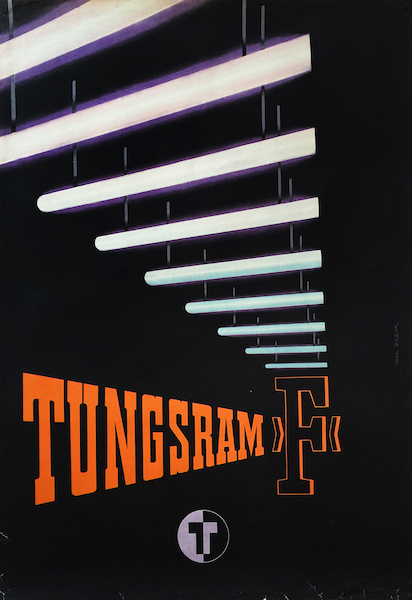
Pal Gabor - Tungsram F fluorescent tubes 1953 Hungarian export advertising poster
Besides the usual Socialist Realist design, the original modern ideas also lived through in the 1950's. We sense a continuity of the modern poster design of the 1930's and the modern political poster style of 1945-1949. These tendencies were still working in certain fields of graphic design in the 1950's. Many posters were produced, which didn't strictly follow the obligatory style. There were areas where the state control was weaker, and a certain modern and spectacular poster style could survive.
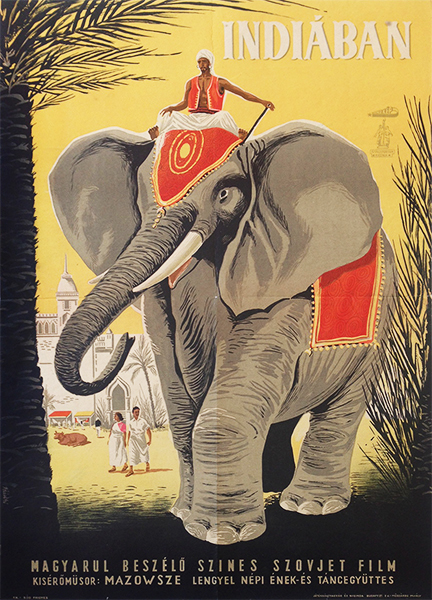
Laszlo Banki - In India 1953 Hungarian movie poster
These posters were usually connected to entertainment: circuses, amousement parks, cultural events and institutions could publish impressive and colorful posters. Funny and playful commercial posters appeared as well, among them colorful designs by Sándor Lengyel, László Káldor, the Macskássy brothers and others. They also created catchy slogans for general products and nationalized trademarks, such as: "Servus Salvus", "Eat fish. it is the best dish", etc. Irén Tomaska presented cartoon-like figures on her commercial posters. Many of these advertised products that targeted children: candies, sweeties, soft drinks, etc., which justifies the cheerful cartoon-like style (the posters of the Zi-zi candy are good examples). Others promoted normal foodstuff and other everyday products. László Káldor's beer and tobacco posters pictured humorous scenes from the everyday life, which made them very popular and memorable.
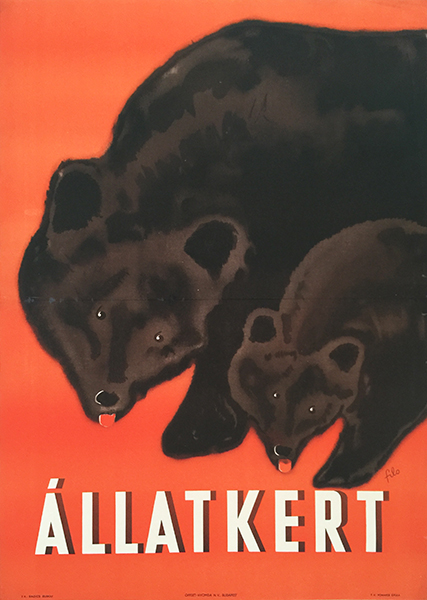
Filo - Budapest Zoo 1950 Hungarian vintage poster
Dénes Vincze created spectacular sport posters, which were close to the Socialist Realist style, but they show artistic value. Every kind of sport (gymnastics, fencing, basket ball, etc.) appear on them, since Vincze created posters for various sport events. He focused on the painting like representation of the athletic human body, which gave his posters eternal beauty.
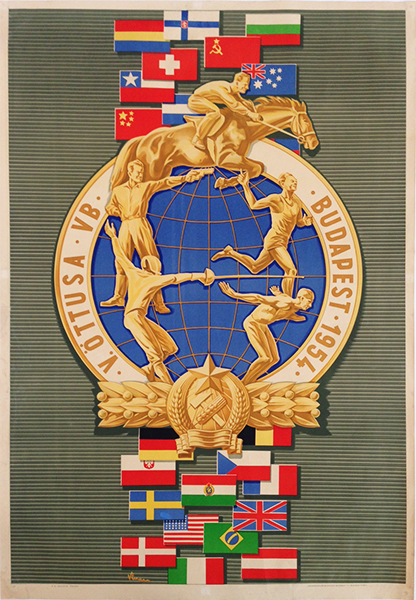
Denes Vincze - V. World Modern Pentathlon Championships Budapest 1954
Some of the movie posters of the age weren't following the strict realist style, in this field a colorful and lovely cartoon like style could emerge. István Köpeczi-Bócz could create fresh and colorful movie and theater posters even in the early 1950's.
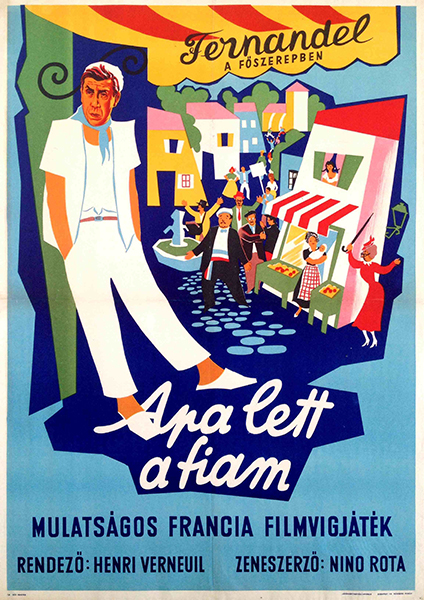
The Wild Oat 1954 Hungarian movie poster
Theatre, circus and other sorts of entertainments required cheerful posters; and the designs by Félix Kassowitz and Eric Vogel provode that. Both of them used humorous scenes and caricature-like funny figures to advertise performances and entertainment programs.
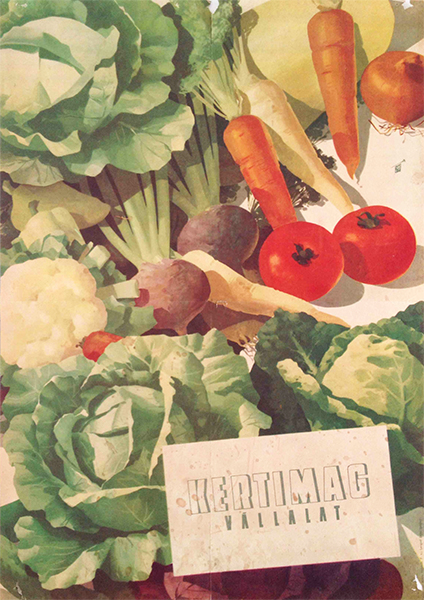
Tibor Piros - Garden Seeds Company 1953 Hungarian advertising poster
Even the realism could produce decorative posters, such as the painted fruit compositions of Tibor Piros, which were usually advertising agricultural events and products.
Take a look at our inventory from this period by: clicking here.